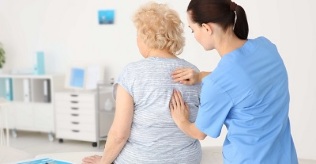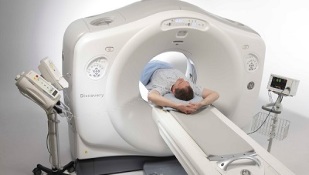
Chest osteochondrosis is rare, but can cause many complications. It is important to make a thorough diagnosis in order to make an accurate diagnosis. Treatment should be timely and comprehensive. Preventive measures help prevent the development of such a disease.
Osteochondrosis of the thoracic spine has a degenerative disorder in cartilage structures. Without timely and competent treatment, osteochondrosis can cause a variety of complications and therefore cannot be ignored. Preventive measures help to avoid such pathology.
General characteristics of the disease
Osteochondrosis is a fairly common lesion of the musculoskeletal system, but rarely affects the thoracic region compared to other parts of the spine. This is due to the fact that this part of the spine is the least mobile, so you experience less stress.
This characteristic is also a risk of the disease - its symptoms are less pronounced, so patients with advanced osteochondrosis see a doctor.
The disease is characterized by degenerative and dystrophic processes. They cause pathological changes in the bone and cartilage tissue. Without treatment, the pathology changes the structure of the ligaments, intervertebral discs, joints, causing destruction.
With the development of osteochondrosis, first the bone structures are affected, then the pathological process spreads to the cartilage structures, muscles and connective tissues. At a young age, such pathological changes trigger premature aging of the body.
Classification
Pathology is characterized by gradual progression, so four stages are distinguished, each of which is characterized by certain clinical manifestations and complications:
- The first stage usually involves rupture of the intervertebral disc, which can cause excessive stress or sudden movement.
- In the second stage, the protrusion of the intervertebral discs is observed. In this case, the disc protrudes in the intervertebral canal - the protrusion is usually no more than half a centimeter. At this stage, spinal instability develops.
- The third stage of osteochondrosis is characterized by an increase in the intensity of clinical manifestations and is often accompanied by an intervertebral hernia.
- The fourth stage of the disease is called the most severe and the most dangerous. At this stage, osteophytes appear. Their reproduction puts pressure on the spinal cord and nerve endings.
Causes
Osteochondrosis can develop at any age. The risk of its occurrence is not related to gender.
The disease is often caused by the following factors:
- age - people over the age of 40 are at risk;
- various pathologies of the spine, including curvature of the spine;
- hereditary predisposition;
- trauma resulting in damage to intervertebral discs;
- chronic stress;
- hypothermia;
- hormonal imbalance, metabolism;
- impaired blood circulation in the chest region; Characteristics of professional activity
- that represent an increased burden in the chest region.
Symptoms of Chest Spinal Osteochondrosis
The disease can have various symptoms and sometimes manifests itself atypically. The most common signs of pathology are:
- Pain. This symptom is the main one. Painful feelings usually occur when the body is in a position for a long time, physical exertion, weight lifting. As the pathology progresses, the pain can also be observed at rest, increasing with each movement. It can be boring or painful.
- Crush in the middle of the back. In this case, it is harder for a person to breathe. The pain is felt when you take a deep breath or exhale.
- Parts of the body become numb.
- May cause chills and goosebumps.
- The local temperature of the feet decreases.
- Itching and burning may be felt in the lower extremities.
- If the pathology affects the cardiovascular system, causing malfunction, it can lead to exfoliation of the skin, thinning of the nail plates, and increased brittleness of the nails.
- As osteochondrosis progresses, the organs of the gastrointestinal tract are disrupted, which can lead to a number of symptoms: nausea, heartburn, bloating, diarrhea, constipation, and abdominal pain.

Pain is a major sign of chest osteochondrosis, but can manifest in a completely different way. In some cases, dorsalgia is observed - painful sensations occur in the affected area and persist for a long time. In other cases, dorsago occurs - the pain is intense and sharp, occurs in paroxysms, restricts muscles and interferes with breathing.
The clinical picture of osteochondrosis depends largely on its stage:
- In the first stage of the disease, the intervertebral disc usually ruptures. This phenomenon is manifested by severe pain and muscle tension. The feelings are reminiscent of an electric current, the discharge of which seems to pass along the spine.
- In the second stage, a protrusion is observed, accompanied by pain in the chest region, which can also affect the internal organs.
- In the third stage of the pathology, pain occurs more frequently. The patient has difficulty breathing and a headache appears. The disease can slightly disrupt the work of the heart.
- In the fourth stage, intercostal neuralgia may develop due to compression of the nerve roots. In this case, there is sharp pain in the chest. It only affects one area at first, but then spreads to the chest. This makes it difficult to breathe. The patient is sometimes unable to change the position of the body, the pain associated with various movements often increases and can be unbearable. Due to severe pain, the pupils may dilate.
Symptoms of osteochondrosis of the chest region usually increase at night, which involves the body remaining in a long, horizontal position. After waking up, the symptoms are less intense or disappear completely, but sudden movements or low body temperature can make them worse.
Atypical manifestations of chest osteochondrosis include the following symptoms:
- Painful feelings in the heart region. Such a manifestation raises the suspicion of myocardial infarction or angina pectoris. Sometimes this symptom lasts for several weeks.
- Concentration of pain in the abdomen that causes severe discomfort in the gastrointestinal tract. This symptom increases with physical activity.
- Sharp spastic pain in the upper abdomen. This symptom is characteristic of gastritis, pancreatitis, cholecystitis.
- In women, worsening of the disease can cause pulling pain in the mammary glands. In this case, a malignancy is suspected.
- Violation of the urogenital organs.
- If the abnormalities are concentrated in the upper part of the chest region, the pain may affect the esophagus or pharynx. Patients in this case complain of feeling a foreign object in the throat.
Only a doctor can diagnose. Chest osteochondrosis is associated with a number of symptoms that are common to other pathologies. A trained professional will be able to understand all shades of the clinical picture.
Diagnostics
Your doctor may make a preliminary diagnosis as early as the initial examination of the patient. Usually, a neurologist deals with the problem of osteochondrosis. The doctor examines the spine in different body positions.
Instrumental diagnostics are used to confirm the diagnosis and identify the characteristics of the pathology. The basic examination is the X-ray.

In addition, the following measures can be applied:
- computed tomography;
- magnetic resonance imaging;
- scintigraphy;
- discography;
- electromyography.
They also use laboratory diagnostics. This may consist of general and biochemical blood and urine tests. Such tests are performed for the purpose of differential diagnosis, revealing the characteristics of the pathology, the associated complications.
Diagnosis is needed not only to confirm the diagnosis but also to distinguish between osteochondrosis and other pathologies. The atypical course of the clinical picture may be similar to other pathologies that may not even be associated with the thoracic region.
Treatment of osteochondrosis of the thoracic spine
The disease requires complex treatment. This includes not only the use of drugs, but also various physiotherapy methods, physiotherapy practices, massage.
Bed rest is required if the disease worsens. Mobility should be limited as much as possible. Often the pain syndrome is so severe that the patient calls an ambulance. In this case, the treatment is performed in a hospital setting.
Restricts movement during treatment. When you no longer need bed rest, you can walk, but long walks are forbidden. Walking should be alternated with rest. You should not sit in any position for long.
When the disease has progressed, they resort to adhesion. This technique involves stretching the spine. This allows you to increase the distance between the vertebrae, reduce the size of the intervertebral hernia, and activate the nutrition of the intervertebral plates.
Drug therapy
Various medications for breast osteochondrosis are used to relieve pain, muscle tension, and improve blood supply. The following medications can be prescribed for this purpose:
- Medication is usually based on a non-steroidal anti-inflammatory drug that relieves pain and eliminates inflammation. Such drugs are prescribed in the form of ointments and gels for external use, tablets and capsules for oral administration, solutions for injection. Therapy may involve the simultaneous use of several forms of drugs belonging to the same group. The therapy course usually lasts 1-2 weeks.
- Use glucocorticosteroids in severe pain. Medicines are usually used for intramuscular injections or for physiotherapy.
- Painkillers are also used for severe pain.
- In case of unbearable pain, they resort to drug blocking. Blockades are performed strictly according to the indications in a hospital setting.
- Local irritants can help reduce pain. They can be based on natural ingredients - hot pepper extract, bee or snake venom.
- Intramuscular injections of nicotinic acid are prescribed in the affected area to restore blood circulation.
- Muscle relaxants are used to relieve muscle tension.
- After stopping the disease from getting worse, medications are often prescribed to activate metabolic processes and restore cartilage structures. This effect is provided by chondroprotectors. These drugs are a long course of therapy lasting several months.
Only one doctor can prescribe a medication that is needed in a particular case. The duration and system of taking each drug should be determined, taking into account the compatibility of different drugs.
Physiotherapy and massage
In the case of thoracic osteochondrosis, physiotherapy methods make it possible to relieve pain and restore mobility. Your doctor may prescribe the following treatments:
- electrophoresis or phonophoresis drugs, including anti-inflammatory and analgesic drugs;
- magnetic therapy;
- darsonvalization; paraffin wax applications;
- ozokeritotherapy;
- balneotherapy;
- ultrasound;
- mud therapy;
- UHF therapy.

Particular attention should be paid to the massage of chest osteochondrosis. The following techniques can be used to treat this pathology:
- Classic.In this case, the massage consists of light caressing, kneading, pinching, rubbing. Such treatment should be a course. A course can include up to 15 sessions, each lasting up to 20 minutes.
- Patch.The effect can be applied to painful or acupuncture points. The movements are performed in a circle with fingertips, with a gradual increase in compressive force.
- Canned.Using cans allows you to create a vacuum that increases blood circulation and lymphatic drainage. The cupping massage increases muscle tone, eliminates abnormal reflexes and accelerates the microcirculation of various body fluids.
- Segment.This massage is performed to improve the blood supply to the affected area, stimulate lymphatic drainage and oxygenate the tissues.
Physiotherapy
Physiotherapy practices have an excellent effect on chest osteochondrosis. It should be done under the supervision of a professional, but some exercises can also be done at home:
- Warming up before physiotherapy. To do this, you can take a shower and do a little warm-up. It consists of hand movements, rotations, body turns.
- Lie on the floor, on your stomach. Put both hands behind your head while spreading your elbows wide. Slowly raise your shoulders and body. Pull up the right elbow first, then the left. Perform 5 repetitions.
- In the same starting position, place your hands behind your back and lock them in the lock. When bending the torso, raise your arms without opening them. At the outermost point, it should drag on for a few seconds, smoothly returning to its original position.
- Go to the ground and put your hand behind your shoulder. Alternately, lift your shoulders, moving your head in the same direction.
- Lie on a hard surface, on your stomach. Stretch your arms forward while lifting your body. Perform several repetitions and then perform the same body lifts but with arms along the body.
- Sit in a chair and place both hands on your belt. Move the shoulder strap, lift it smoothly and lower it to its original position. At the most extreme moment, you need to linger for a few seconds. Perform 5 repetitions.
- This exercise should be done with a gymnastic stick. While inhaling, sit down and raise your arms, keeping a stick in them. When exhaling, return to your starting position and tilt your body forward.
- Go to the ground and put your hand on your shoulder using a gymnastics. Then tilt your body left and right. This practice is contraindicated in scoliosis.
- Sit on a chair with a backrest, lean on it and lean back.
All exercises should be done smoothly and slowly. Sudden movements are excluded. If an exercise is painful, stop exercising and relax. If the pain persists, the exercise should be stopped and a doctor consulted.
Prognosis, complications
With timely detection and appropriate treatment of chest osteochondrosis, the prognosis is favorable. If the disease is neglected, life expectancy is reduced by about 7%.
Progression of osteochondrosis can lead to other pathologies:
- protrusion of the intervertebral disc as it protrudes into the intervertebral canal;
- intervertebral hernia - in contrast to the protrusion, involves rupture of the annulus fibrosus; narrowing of the intervertebral canal, spinal artery
- ;
- radiculopathy - a complex of symptoms that occurs when the roots of the spinal cord are damaged;
- kyphosis - commonly known as humpy, and involves curvature of the spine with the direction of bulge (sagittal plane);
- pneumosclerosis;
- shingles;
- malignancies;
- sexual dysfunction.
Prevention
It is easier to prevent any disease than to stop and cure the pathological changes that have already taken place.
Observing the following preventative measures will help prevent breast osteochondrosis:
- Maintain a normal body weight.
- Moderate physical activity. Regular exercise or at least daily exercise is required. It is essential to include back muscle strengthening elements in the range of exercises.
- Avoid injuries, physical overload.
- Correct posture, correct if necessary.
- Avoid emotional overload, stress.
- Proper nutrition.
- Eliminate bad habits.
- Arrange the sleeper correctly. It is important to choose the right strength of the mattress, tailored to individual characteristics.
- Proper organization of the workplace. If your work is sedentary, you should take care of a high-backed chair. Breaks should be taken and warmed up during these.
- Timely medical examinations.
- Complete and timely treatment of all pathologies.
There can be various complications of osteochondrosis of the thoracic spine that negatively affect quality of life. It is necessary to consult a doctor at the first signs of pathology, who will diagnose and prescribe the appropriate treatment. All regulations must be strictly adhered to.























